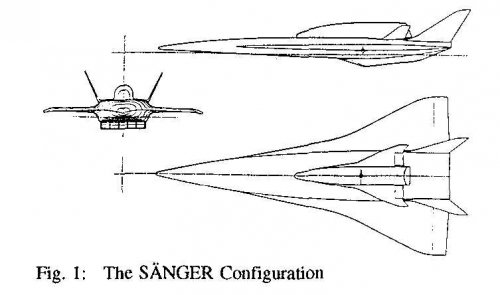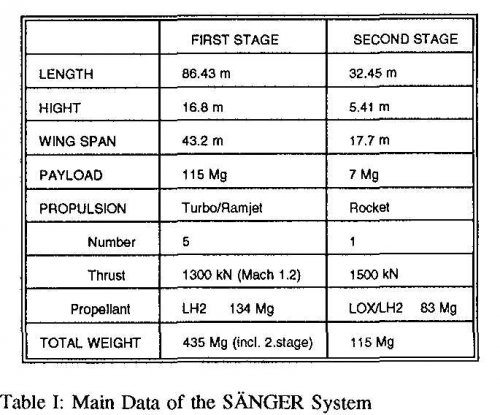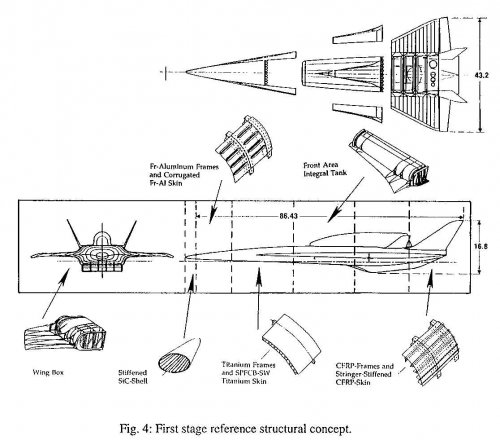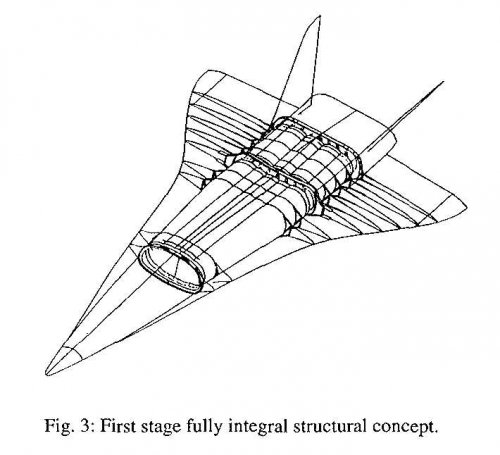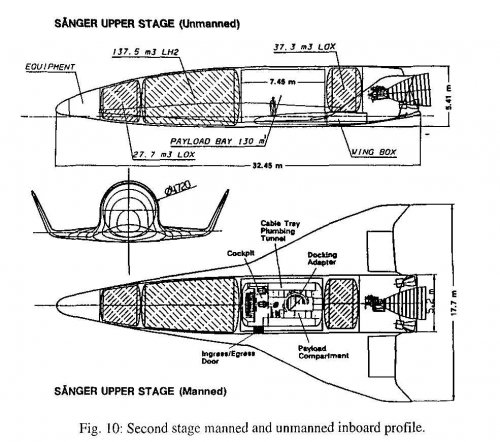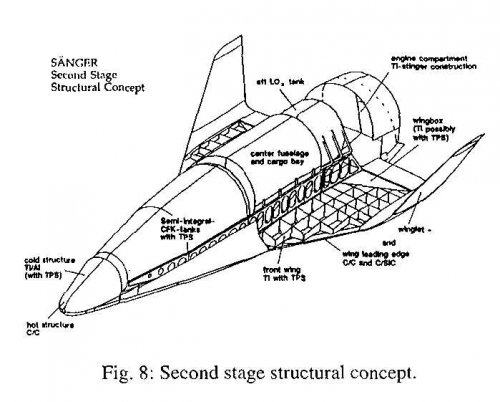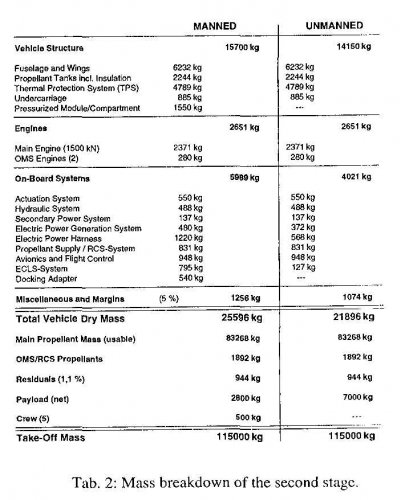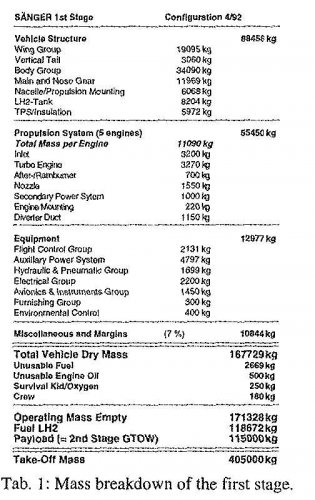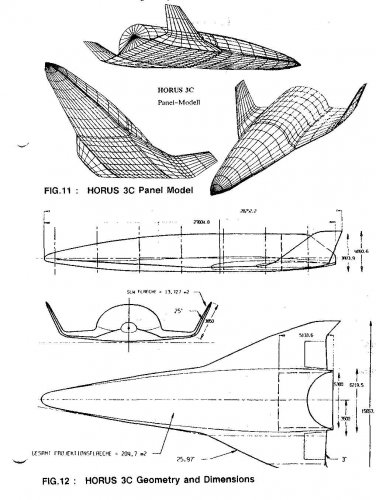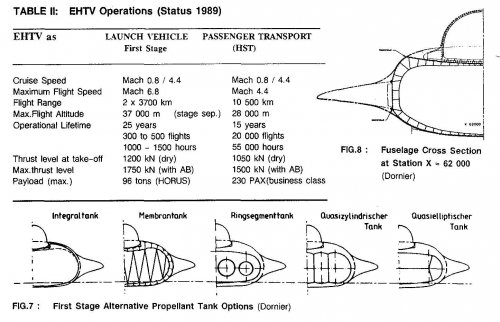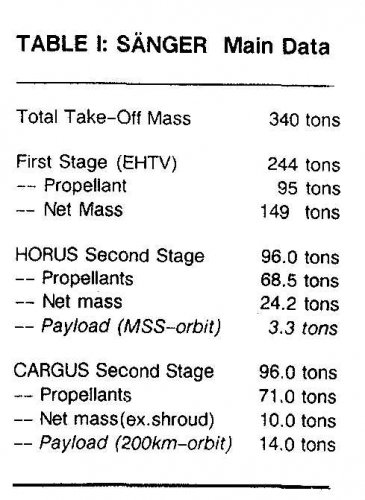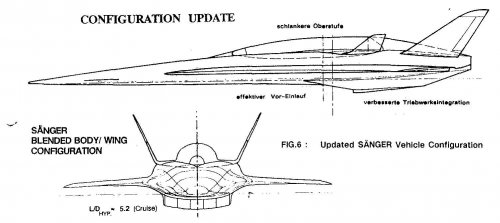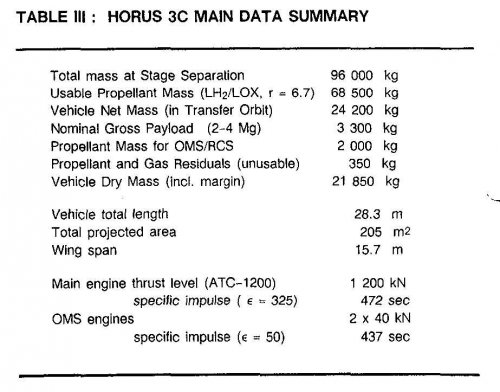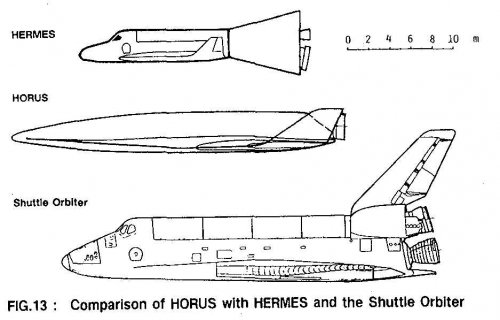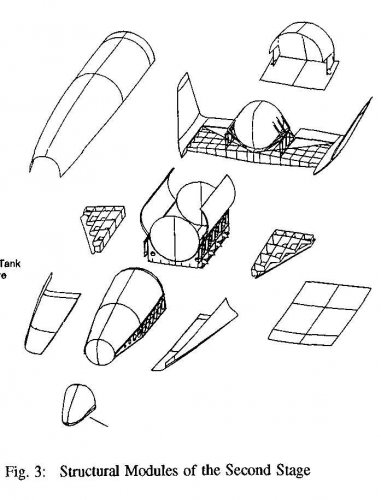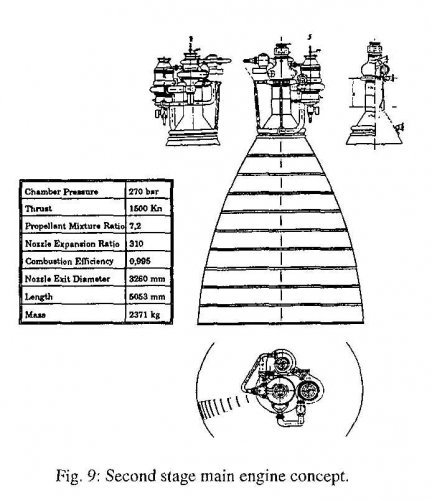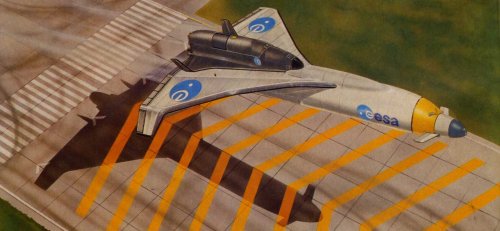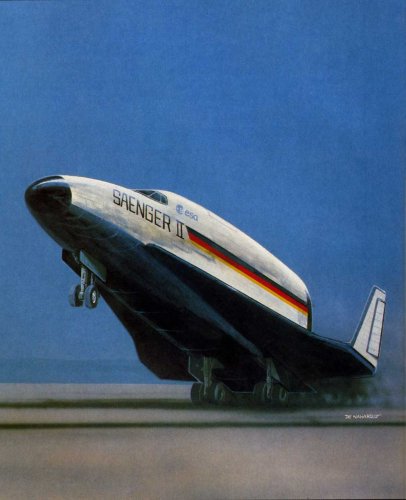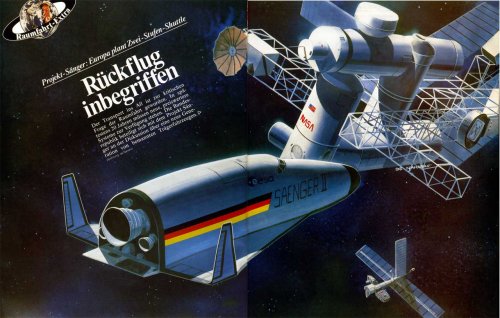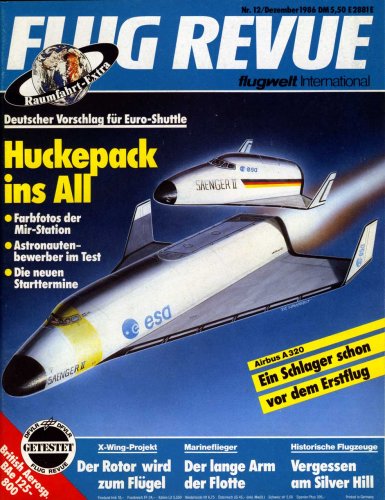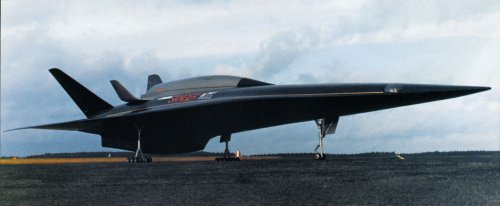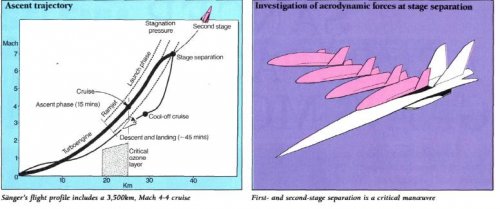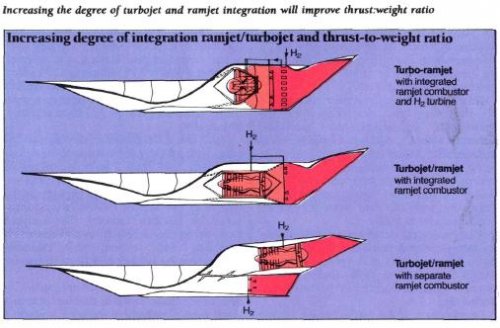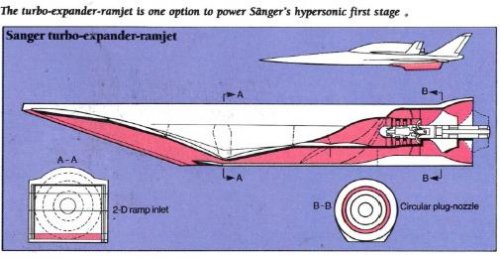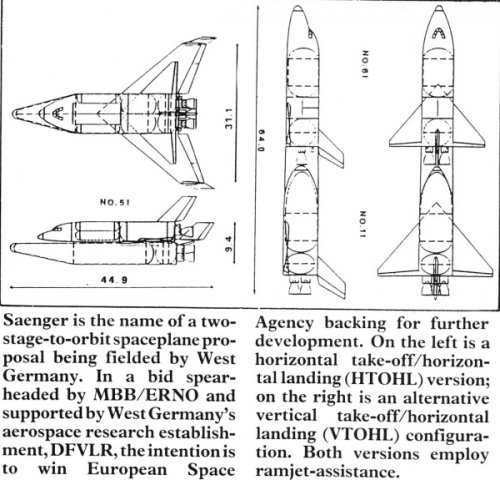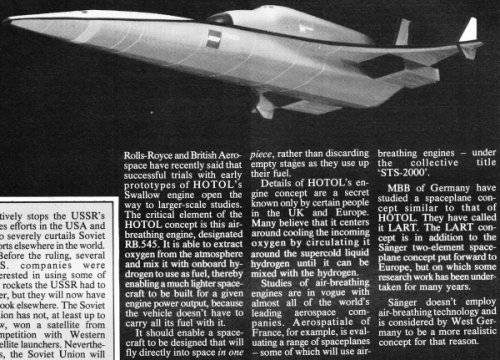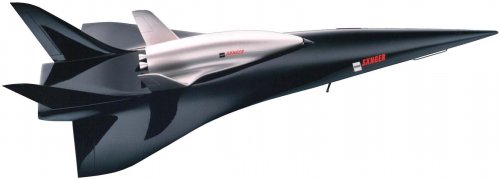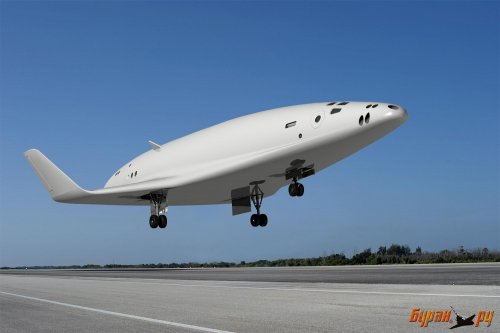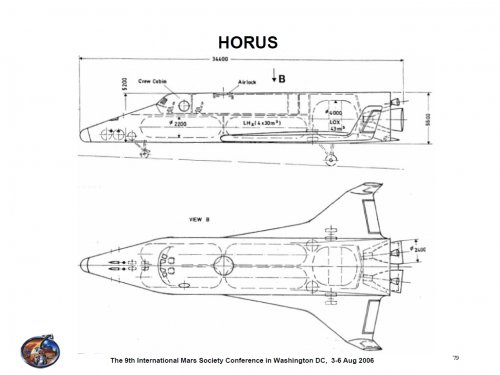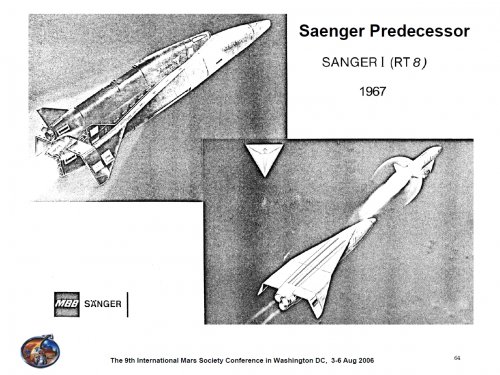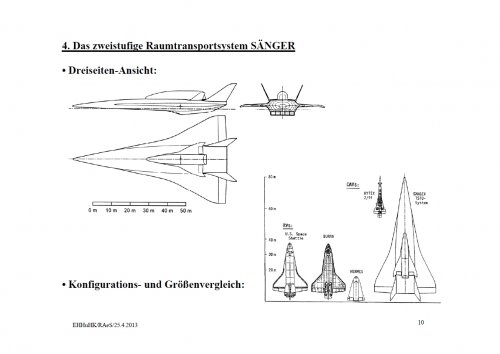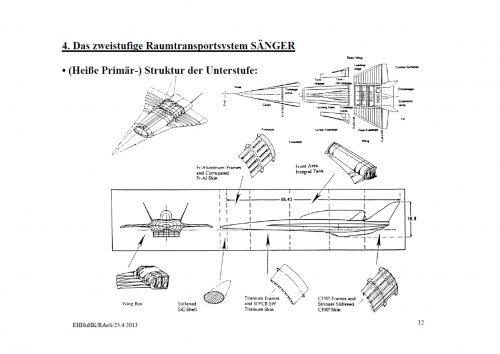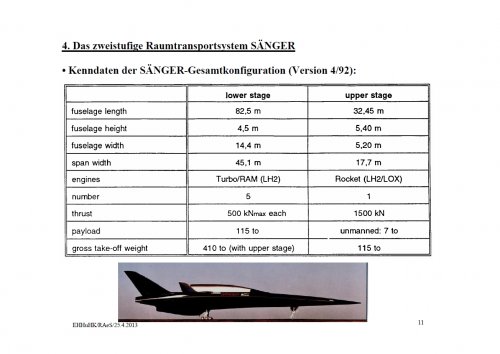Tuomasn
ACCESS: Secret
- Joined
- 5 January 2006
- Messages
- 474
- Reaction score
- 321
I've always found the German Sänger 2 project interesting, even if it wasn't technologically very feasible.
The development of the Sänger II began at Deutsche Aerospace in 1985. It was the reference vehicle of the German Hypersonics Program and received most of the domestic funding for spaceplane development. The Sänger II was a two stage to orbit vehicle with a large hypersonic air-breathing first stage and a smaller rocket-powered upper stage. The first stage was designed for maximum commonality with a supersonic passenger transport with a Mach 4.4 cruise range of 11,000 km. The upper stage could be a manned reusable HORUS (Hypersonic Orbital Reusable Upper Stage) or an expendable CARGUS (CARgo Upper Stage) for heavy payloads. Full development could have begun in 2004, but the program was cancelled in 1994 for cost reasons. A single Sänger vehicle would have costed about $ 500 million, total program cost would have been $ 20 billion. Design lifetime was 300-500 flights for Sanger, 100-120 orbital flights for Horus.
Sänger II (EHTV)
Crew: unmanned
Length: 84.5 m
Diameter: 14.0 m
Span: 41.4 m
Gross mass: 249,000 kg
Empty mass: 149,000 kg
Propellant mass: 95,000 kg
Engines: 5 x Co-axial turboramjet
Sea-level thrust: 5 x 300 kN
Propellants: Air/LH2
Burn time: 6,565 s
Hypersonic lift-to-drag ratio: 4.8-5.3
Maximum speed: Mach 6.8
Horus
Crew: 2
Length: 27.6 m
Diameter: 5.5 m
Span: 15.6 m
Gross mass: 96,000 kg
Empty mass: 23,100 kg
Propellant mass: 69,600 kg
Payload: 6,000 kg to LEO; 3,300 kg to space station Freedom with personnel
Engines: 1 x ATCRE (ATC-700)
Vacuum thrust: 1,280 kN
Propellants: Lox/LH2
Burn time: 298 s
Cargus
Crew: unmanned
Length: 32.8 m
Span: 15.6 m
Gross mass: 96,500 kg
Empty mass: 11,500 kg
Propellant mass: 71,000 kg
Payload: 14,000 kg to LEO; 2,500 kg to GEO
Engines: 1 x Ariane 5 engine
Propellants: Lox/LH2
I have seen varying dimensional and performance figures, probably from different stages of the vehicle's evolution. Any feedback or corrections to the above data would be appreciated. Also any pictures besides those at http://www.astronautix.com/lvs/saegerii.htm and those of the Revell model would be nice. IIRC a scale model was constructed and should now be on display somewhere. Any pics of it? Also anything more on the EHTV (European Hypersonic Transportation Vehicle) passenger airplane version of the first stage.
The development of the Sänger II began at Deutsche Aerospace in 1985. It was the reference vehicle of the German Hypersonics Program and received most of the domestic funding for spaceplane development. The Sänger II was a two stage to orbit vehicle with a large hypersonic air-breathing first stage and a smaller rocket-powered upper stage. The first stage was designed for maximum commonality with a supersonic passenger transport with a Mach 4.4 cruise range of 11,000 km. The upper stage could be a manned reusable HORUS (Hypersonic Orbital Reusable Upper Stage) or an expendable CARGUS (CARgo Upper Stage) for heavy payloads. Full development could have begun in 2004, but the program was cancelled in 1994 for cost reasons. A single Sänger vehicle would have costed about $ 500 million, total program cost would have been $ 20 billion. Design lifetime was 300-500 flights for Sanger, 100-120 orbital flights for Horus.
Sänger II (EHTV)
Crew: unmanned
Length: 84.5 m
Diameter: 14.0 m
Span: 41.4 m
Gross mass: 249,000 kg
Empty mass: 149,000 kg
Propellant mass: 95,000 kg
Engines: 5 x Co-axial turboramjet
Sea-level thrust: 5 x 300 kN
Propellants: Air/LH2
Burn time: 6,565 s
Hypersonic lift-to-drag ratio: 4.8-5.3
Maximum speed: Mach 6.8
Horus
Crew: 2
Length: 27.6 m
Diameter: 5.5 m
Span: 15.6 m
Gross mass: 96,000 kg
Empty mass: 23,100 kg
Propellant mass: 69,600 kg
Payload: 6,000 kg to LEO; 3,300 kg to space station Freedom with personnel
Engines: 1 x ATCRE (ATC-700)
Vacuum thrust: 1,280 kN
Propellants: Lox/LH2
Burn time: 298 s
Cargus
Crew: unmanned
Length: 32.8 m
Span: 15.6 m
Gross mass: 96,500 kg
Empty mass: 11,500 kg
Propellant mass: 71,000 kg
Payload: 14,000 kg to LEO; 2,500 kg to GEO
Engines: 1 x Ariane 5 engine
Propellants: Lox/LH2
I have seen varying dimensional and performance figures, probably from different stages of the vehicle's evolution. Any feedback or corrections to the above data would be appreciated. Also any pictures besides those at http://www.astronautix.com/lvs/saegerii.htm and those of the Revell model would be nice. IIRC a scale model was constructed and should now be on display somewhere. Any pics of it? Also anything more on the EHTV (European Hypersonic Transportation Vehicle) passenger airplane version of the first stage.

